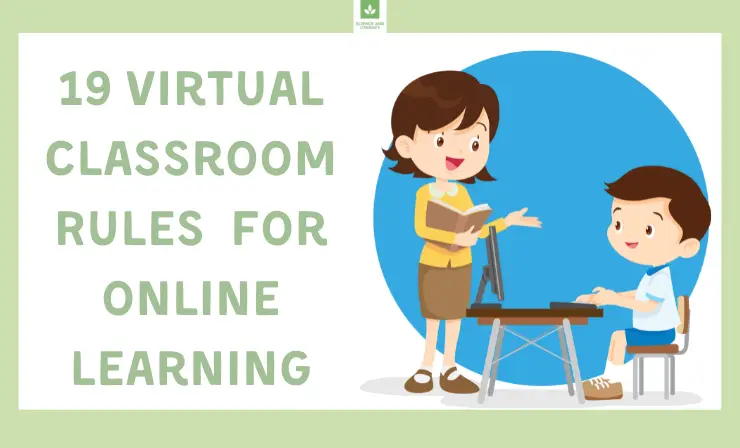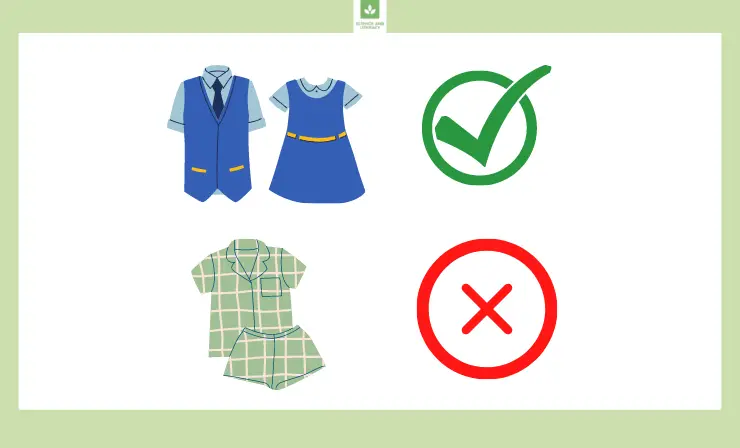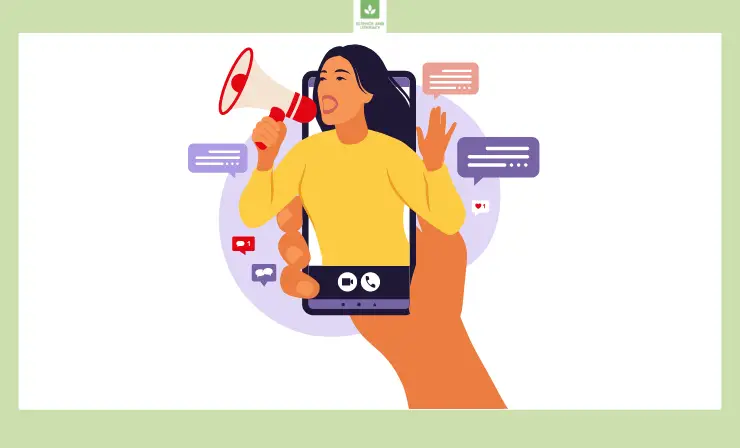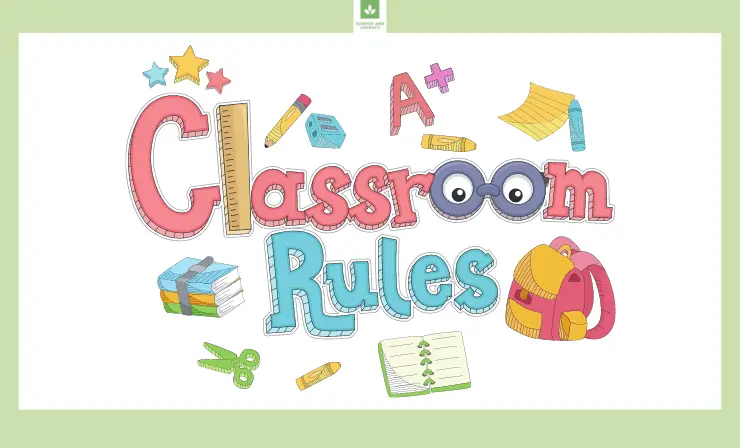We hear a lot about how adjusting to virtual instruction can be challenging for students. However, if you’re a teacher who was used to in-person teaching, you already know what a huge adjustment it has been for you as well.From my discussions with teachers, one of the biggest things they seem to struggle with is classroom management and classroom rules when teaching virtually. I know it was one of the things I struggled most with too when I made the transition to virtual teaching.

My first few weeks (or probably months, if I’m to be honest) of teaching virtually did not go as I would have liked. My students were not all attending class, if they did their camera was off or they either weren’t participating or were yelling over one another.It was a mess. I knew something had to change or no one would be able to learn anything.
That’s when I started doing some research on the best classroom rules to help with virtual instruction. I combined what I read with a few of my own ideas, and it really helped turn my class around.
Would you like to find out what I learned about what virtual classroom rules teachers do use? Continue reading, and I’ll share:
- The best virtual classroom rules to implement right away →
- Why rules are important in a virtual classroom setting →
- How to create a positive environment for virtual learning →
19 Virtual Classroom Rules
If you’re wondering, “what virtual classroom rules teachers do use,” you’re in the right place! Let’s take a look at some classroom rules that are popular with teachers engaging in virtual instruction.
1. Log In on Time
Logging in on time is an essential online classroom rule to share with your students. If they aren’t on time to class, they will miss important learning. Some students (and parents) may see virtual instruction as more flexible, but you need to convey the point that it is just as important to be logged in on time as it is to be in the physical classroom at the beginning of class.

2. Be Prepared
In addition to being on time, students should also be prepared for each virtual class. They should have their computers, headphones, paper, pencil, and any other materials that you have specified ahead of time.
3. Dress for Learning
Encourage students to dress as they would for going into school. While pajamas may be comfy, they won’t help put students in the right mindset that they are ‘in school’ to learn and work hard.

4. Choose a Good Work Space
When discussing the classroom rules together, stress to each student how important it is for them to find a quiet place in their home to work. When possible, they need to be away from siblings or other distractions.
5. No Eating During Class
Eating can be distracting, so remind students to eat before or after class. You may decide to allow each student to have a bottle of water nearby if they get thirsty.

6. Camera On
Students should have their cameras on during instruction. It helps you see who is present and who is paying attention.
7. Microphone Muted
When it isn’t their turn to speak, remind students to keep their microphone muted. This will limit call-outs and side conversations.

8. Raise Your Hand to Speak
Just as students would in the classroom, they should raise their hand and wait to be called on in the virtual distraction. Too many students yelling out an answer will make it difficult for anyone to learn or hear others.
9. One Speaker at a Time
Similarly, only one person should be speaking at a time. To model the importance of this rule, you can have all students talk at the same time and tell another student something. Then, ask who was actually able to hear anything.

10. Focus on the Speaker
Students should be focusing their attention on the person speaking, whether it is the teacher or another student. This means looking at the person on the screen, listening, and taking notes (if necessary).
11. Distractions Away
When students come to virtual class, they should be focused on the learning. This means phones, toys, or other distractions should be put and kept away.

12. Be Respectful
Being respectful in the virtual classroom is as important as it is in an in-person setting. Students should use kind words, pay attention, and think about others’ feelings.
13. Stay Positive
Help your students see the importance of positivity. Remind them to always try their best and believe in themselves (and their peers).

14. Encourage One Another
Likewise, another important virtual rule for students it to encourage each other and try to help their classmates feel better about their abilities. This will look different in the virtual classroom, but it might mean sending encouraging notes or emojis through the chat.
15. Check the Class Page for Announcements
If you have a class page or send out regular emails with updates or notices, remind students that it is their responsibility to check these sources on a regular basis. They should respond to questions or make sure they bring any of the materials you note in each message to class.

16.Complete and Submit Assignments and Homework on Time
Another important remote learning rule is to make sure assignments are completed and submitted on time. Make sure students understand the process for turning in virtual assignments to help ensure that everything is submitted on time.
17. Ask Questions
Encourage students to ask questions when they are unsure about something. Help them feel comfortable asking questions and explain how this is one strategy good learners do to help them learn and understand new information.

18. Only Share On-Topic Comments
Staying on topic can be a challenge for students of all ages. Making it a classroom rule, and providing students with reminders when needed, can help encourage your students to focus on the learning at hand and limit off-topic comments. With virtual instruction, staying on topic also refers to the written comments or notes students may send through chat.
19. Have Fun
Finally, remember that we want to make learning as fun as possible for our students. The final rule to share with students is to have fun. Hold them accountable to the other rules, but be sure to leave plenty of time for fun and engaging tasks and learning opportunities.
They understand our virtual classroom rules! Winning! pic.twitter.com/NvvkQxFauP
— Tywanda Wlliams (@Tywilllliams) September 4, 2020
This video goes into greater detail about some of the rules shared above. It also includes a student showing examples and non-examples of how to follow each rule. It may be a good resource to share with your students as you’re discussing the rules for your virtual classroom.
I also like this video for introducing students to class rules for virtual instruction. I like that it reads each rule to students and that is has some upbeat music to help them stay focused on the content.
Here is one more video that you may want to share with your students about online classroom rules. This video displays each rule, but doesn’t read the text to students. It may be a better option if you teach older students who are already reading independently.
What do you think? Will these videos help you introduce your new virtual classroom rules to your students?
Why Rules Are Important In A Virtual Classroom Setting
Rules are important for any classroom, whether virtual or in-person. Writing out your rules on one of the slides for your lesson or displaying them using your document camera can help students know what is expected of them. When you have clear rules in place, students are able to focus on learning. They will be less likely to get distracted and more able to attend to what is most important.

Having classroom rules in place from the beginning can also help you as a teacher to minimize interruptions to your lessons. Students won’t be as likely to try to argue or question you when you enforce a rule if they already know what it is. This leaves less gray area for the students as well, and lets them know what is and isn’t acceptable behavior.
In addition to sharing the virtual classroom rules with students at the beginning of the year, it is also important to revisit the rules regularly. Reviewing them and discussing them will help students remember what is expected of them.
You can use this short video when reviewing the rules. The music and illustrations will help hold students’ attention.
After your students watch the video, be sure to hold a short discussion reviewing what they watched. You can also ask students to share what the rules are for your virtual class and why they think each rule is important.
How To Create A Positive Environment For Virtual Learning
Having strong virtual classroom rules is just one of the necessary components when trying to create a positive environment for virtual learning.

Here are a few other tips to help you create a positive environment where your students will feel comfortable learning, sharing, and taking risks:
- Start each day/class period with a greeting/welcome. You could even use a camera to record yourself doing something silly to play for each lesson.
- Take time to get to know each student and ask them questions about their interests.
- Layout expectations/schedules to help students know what they can expect. In the classroom, you might have displayed your schedule on the interactive whiteboard, but for virtual learning you can add it to one of the slides in your lesson.
- Acknowledge and praise positive behavior from students. You may also want to come up with a reward system.
- Communicate and hold students accountable.
- Connect with families for support when needed or to praise good effort.
Useful Recourses:
- English worksheets and online exercises
- Guide to Online Lesson Planning
- Eight Tips for Successful Online Learning
Final Word
If you started reading this article with the question, “what virtual classroom rules teacher do use,” I hope I was able to help you find the answers you were looking for. Which of the virtual classroom rules that I shared do you think you’re going to implement in your online classroom? How do you think it will improve your lessons and how your students learn?
- Overview of 22 Low-Code Agencies for MVP, Web, or Mobile App Development - October 23, 2024
- Tips to Inspire Your Young Child to Pursue a Career in Nursing - July 24, 2024
- How Parents Can Advocate for Their Children’s Journey into Forensic Nursing - July 24, 2024

I am concerned about a question. Do you think you need breaks during online learning?
I believe that breaks are necessary. Firstly, students can get tired of sitting at the computer. Secondly, it’s bad for their eyesight. And thirdly, they can get hungry, can’t they?